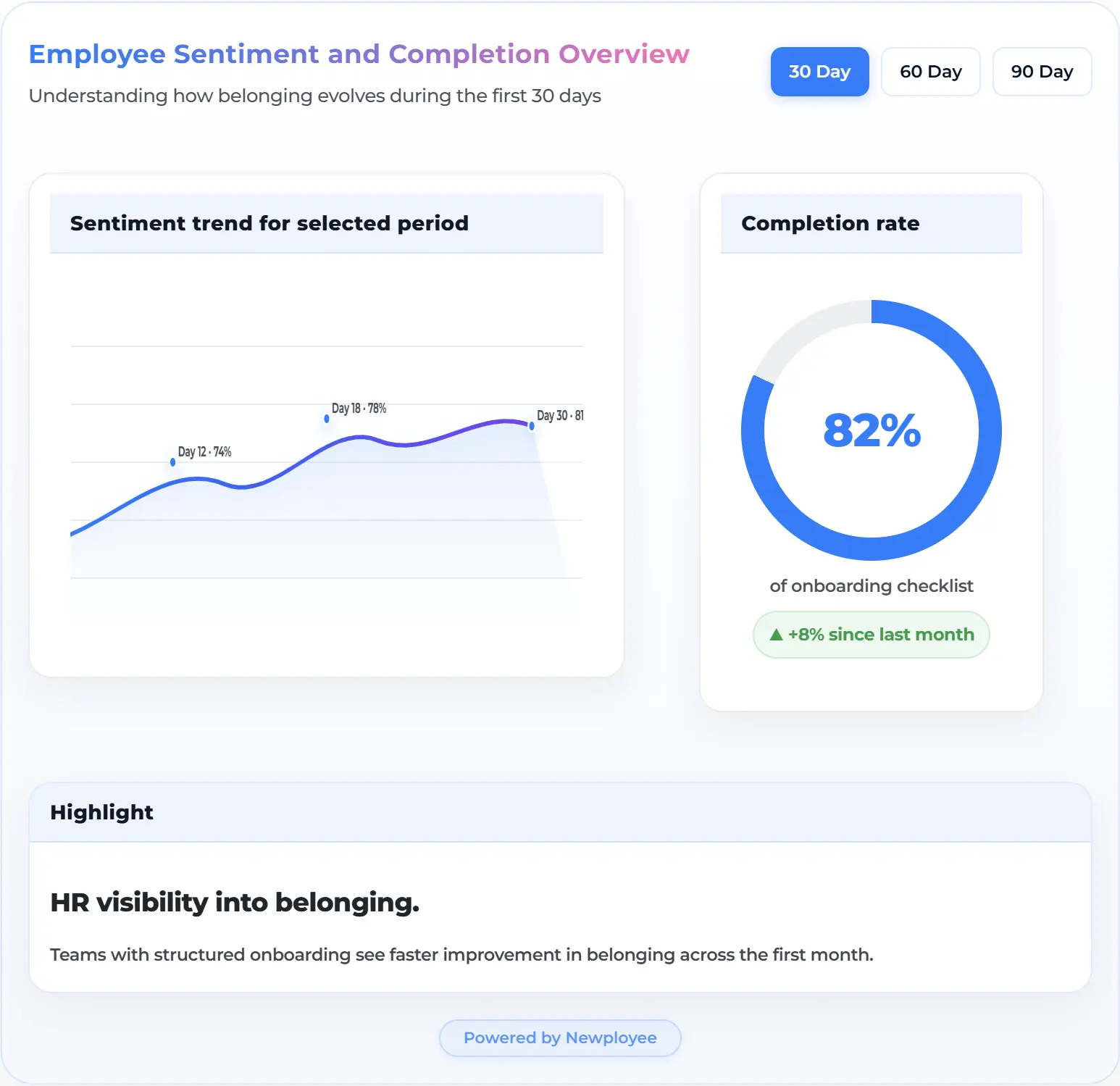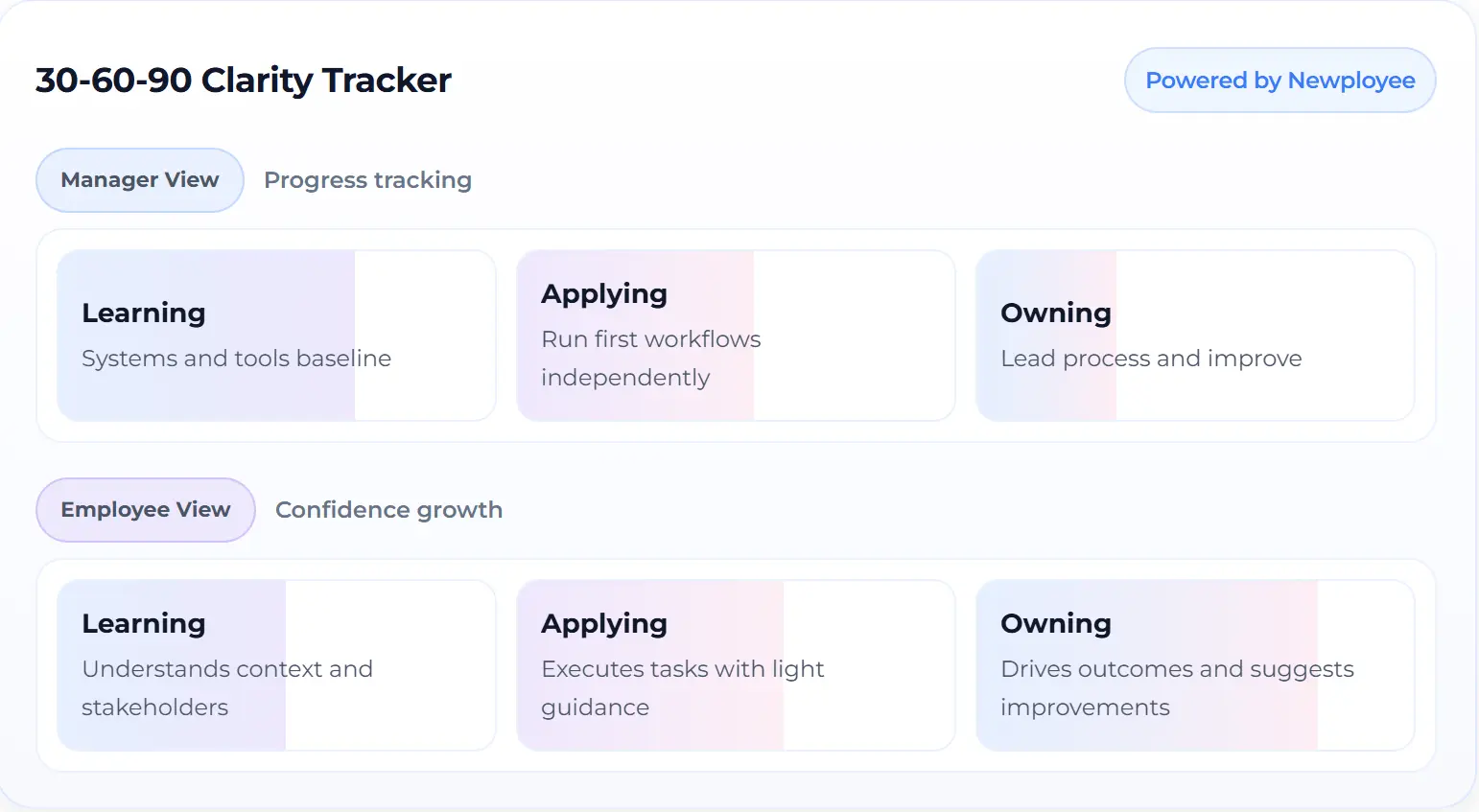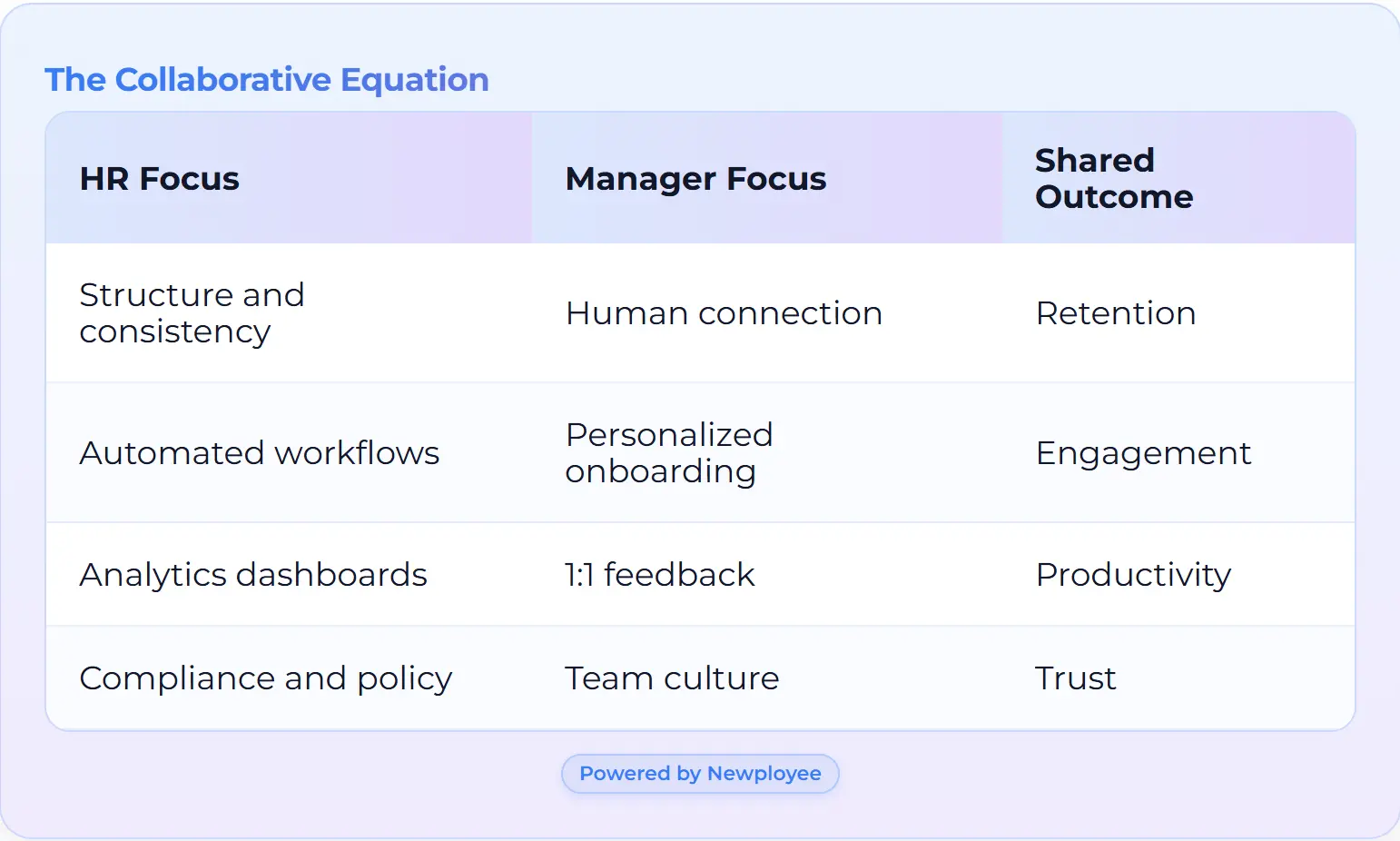Oliver Bennett
Sales Development Rep



October 29, 2025
13
min read

Remote employee onboarding works best when HR and managers act as partners, not duplicates.
Each plays a distinct yet interconnected role in shaping how new hires experience their first weeks.
HR is the architect of the experience.
Before a single Slack message is sent or a Zoom call is booked, HR designs the invisible framework that defines how a new hire feels during their first weeks.
Remote employee onboarding begins long before Day 1.
It starts the moment a new hire says “yes.”
From that moment on, HR’s role is to ensure the entire journey feels intentional, not accidental.
A remote employee can’t “stumble into culture.” They must be guided into it.
That means HR needs to orchestrate every step:
When teams scale, chaos loves to hide in inconsistency.
Two managers might onboard new hires in two completely different ways, one deeply structured, one chaotic.
HR’s role is to ensure that no matter where the new hire lands, the quality of the onboarding feels identical.
This is where automation becomes empathy’s best friend.
With structured workflows, HR can guarantee that every new hire:

What gets measured gets improved.
Modern HR teams go beyond task tracking; they measure emotion.
Using tools like Newployee, HR can see how engaged new hires feel through sentiment surveys, completion analytics, and time-to-productivity reports.
The data tells a story: who’s thriving, who’s stuck, and where the handoff between HR and managers needs work.
When HR measures sentiment, they’re not tracking forms; they’re tracking belonging.

If HR builds the system, managers bring it to life.
A new hire doesn’t feel part of the company because of forms or checklists. They feel it because of a human being who makes space for them.
That human is usually their manager.
Remote onboarding magnifies this truth.
Without daily hallway hellos or spontaneous coffee chats, managers become the emotional infrastructure of belonging.
The first few days are less about performance and more about reassurance.
A manager’s role is to make the new hire feel seen, safe, and supported from day one.
Practical actions:
Managers transform uncertainty into direction.
A remote new hire doesn’t just need tasks; they need clarity on priorities, culture, and unwritten rules.
Without it, even the most talented hire can feel lost.
Best practices:

Feedback is the bridge between effort and recognition.
Remote employees often fear they are working in silence, unseen behind their screens.
Managers close that gap with frequent, meaningful feedback loops.
Ways to reinforce belonging:
Managers don’t just represent the company. They embody it.
In a remote world, they become the living proof of values, tone, and empathy.
Every one-on-one, every Slack message, every response defines what “normal” feels like for a new hire.
The real magic of onboarding happens not in the forms or workflows, but in the spaces where people collaborate.
HR and managers operate in different worlds, one defined by process and the other by people, but when they align, onboarding transforms from a task into a shared story.
HR brings structure, systems, and visibility.
Managers bring context, coaching, and connection.
When these two forces work together, the experience feels both consistent and deeply personal.
This collaboration turns onboarding into what it was always meant to be: a bridge between belonging and performance.

Data means nothing without conversation.
HR analytics show completion rates, time to productivity, and sentiment scores, but managers translate those numbers into stories and action.
When HR spots a drop in engagement, managers open a conversation.
When HR automates workflows, managers personalize the moments that matter.
When HR measures sentiment, managers respond with empathy.
The technology that supports onboarding should not replace human interaction; it should amplify it.
That is where Newployee acts as the connector.
HR teams design automated journeys, and managers personalize them with context.
Every message, reminder, and dashboard becomes part of a shared ecosystem where systems support stories and data fuels empathy.
When data meets empathy, onboarding becomes transformation.
Even the best teams need the right tools.
Newployee connects HR structure with manager empathy through smart automation, shared visibility, and human-centered analytics.
A single place where HR and managers see the same truth. Journey status, risks, and next steps are visible per new hire and per cohort.
HR defines the workflow. Newployee triggers the right reminder for the right person at the right time.
Examples include Slack nudges for first week check ins, automatic access follow ups, and day 30 reflection prompts.
HR ships consistent experiences using prebuilt templates for remote onboarding, manager handoffs, buddy programs, and compliance packs.
Managers personalize the tone and context without breaking the flow.
Sentiment is captured at pivotal moments.
Day 3, day 7, day 14, day 30. Micro pulses track clarity, belonging, and tool readiness.
Newployee ties onboarding quality to retention, ramp speed, and engagement. HR sees patterns. Managers get coaching moments.
For execs and HR.
One page summary of the entire onboarding pipeline.
Key tiles include active hires, at risk hires, average time to access readiness, first week completion, 30 day confidence, 90 day performance check.
For people leaders.
A short, actionable list.
Today’s actions include a welcome note pending, buddy intro overdue, goal review due, and celebrate a win.
Measures the moment HR hands over to managers.
Tracks delay to first meeting, buddy assignment, role clarity score, and first deliverable defined.
Connects IT provisioning with day one experience.
Metrics include account readiness on time, tool coverage, and blocker categories.
Aligns goals and confidence over time.
Tracks learning, applying, and owning for each role.
Belonging doesn’t happen by chance; it happens through rhythm.
Every message, check-in, and recognition moment reinforces connection.
The Belonging and Feedback Loop in Newployee makes these moments visible, measurable, and consistent across teams.
It captures the emotional heartbeat of onboarding.
Pulse surveys reveal how supported new hires feel.
One-on-one meetings ensure that feedback flows both ways.
Recognition events celebrate early wins and reinforce desired behaviors.
Together they form a continuous loop where data and empathy feed each other; the more you listen, the more your people engage.
HR composes journeys from blocks such as preboarding pack, access setup, culture tour, manager intro, buddy coffee, compliance, first week milestones, 30 day reflection.
Blocks carry timing, owners, and success criteria.
Every touch logs a signal.
Signals feed simple scores such as Access Readiness, Role Clarity, Connection Strength, and Handoff Quality.
Scores drive alerts and coach cards.
When sentiment dips or a milestone stalls, Newployee suggests a short next step.
Example suggests scheduling a clarity check for 15 minutes and providing examples of good first deliverables.
Slack for nudges and celebrations.
Google Workspace and Microsoft 365 for account checks.
Okta for access status.
Jira and Notion for first tasks.
HRIS for employee data.
Calendar for auto-scheduling suggestions.
When HR structure meets managerial empathy, consistency turns into culture.
Newployee gives both sides the rhythm and visibility they need to create a seamless experience.
The KPIs below mark the most important moments of every onboarding journey, from access readiness to confidence and retention.
Together, they help HR and managers coordinate, not control, ensuring every new hire feels guided, supported, and ready to contribute.
HR gains control without becoming the bottleneck.
Templates and analytics create scale and consistency.
Managers gain time for human conversations.
The system handles timing and tasks so leaders can focus on clarity, feedback, and trust.
New hires feel both guided and seen. The path is clear, and the people are present.
A new hire’s first impression begins long before day one.
It’s felt when every login works, the first meeting is ready, and a genuine welcome message arrives.
Those small signals show that the company was prepared for them.
In remote settings, that preparation becomes the language of culture.
HR ensures structure and access, while managers bring warmth and clarity.
Together they create a first week that feels intentional, not improvised.
When HR and managers align, onboarding becomes more than a process.
It becomes the company’s first act of culture and care.